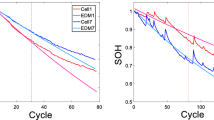Abstract
Artificial Neural Network (ANN) such as backpropagation learning algorithm has been successfully used in slope stability problem. However, generalization ability of conventional ANN has some limitations. For this reason, Support Vector Machine (SVM) which is firmly based on the theory of statistical learning has been used in slope stability problem. An interesting property of this approach is that it is an approximate implementation of a structural risk minimization (SRM) induction principle that aims at minimizing a bound on the generalization error of a model, rather than minimizing only the mean square error over the data set. In this study, SVM predicts the factor of safety that has been modeled as a regression problem and stability status that has been modeled as a classification problem. For factor of safety prediction, SVM model gives better result than previously published result of ANN model. In case of stability status, SVM gives an accuracy of 85.71%.















Similar content being viewed by others
References
Bishop AW (1955) The use of slip circle in the stability of slopes. Geotechnique 5(1):7–17
Bishop AW, Morgenstern NR (1960) Stability coefficients for earth slopes. Geotechnique 10(4):129–150
Boser BE, Guyon IM, Vapnik VN (1992) A training algorithm for optimal margin classifiers. In: Haussler D (ed) 5th Annual ACM workshop on COLT. ACM, Pittsburgh, pp 144–152
Chen WF, Liu XL (1990) Limit analysis in soil mechanics. Amsterdam, Elsevier
Chen WF, Giger MW, Fang HY (1969) On the limit analysis of stability of slopes. Soils Found 9(4):23–32
Cortes C, Vapnik VN(1995) Support vector networks. Mach Learn 20:273–297
Cristianini N, Shawe-Taylor J (2000) An introduction to support vector machine. University Press, London, Cambridge
Dibike YB, Velickov S, Solomatine D, Abbot MB (2001) Model induction with support vector machine: introduction and application. J Comput Civil Eng 15(3):208–216
Fellenius W (1936) Calculation of stability of earth dams. In: Transactions 2nd Congress on large dams, Washington 4:445
Fletcher R (1987) Practical methods of optimization. Wiley, Chichester, Newyork
Gualtieri JA, Chettri SR, Cromp RF, Johnson LF(1999) Support vector machine classifiers as applied to AVIRIS data. In: The summaries of the 8th JPL airbrone earth science workshop
Hoek E, Bray JW (1981) Rock slope engineering, 3rd edn. Institution of Mining and Metallurgy, London
Hudson JA (1992) Rock engineering—theory and practice. Ellis Horwood, West Sussex
Karal K (1977a) Application of energy method. J Geotech Eng Div ASCE 103(5):381–399
Karal K (1977b) Energy method for soil stability analyses. J Geotech Eng 103(5):431–447
Kecman V (2001) Learning and soft computing: support vector machines, neural networks, and fuzzy logic models. The MIT Press, Cambridge
Khan MS, Coulibaly P (2006) Application of support vector machine in lake water level prediction. J Hydrol Eng 11(3):199–205
Lin PS, Lin MH, Lee TM (1988) An investigation on the failure of a building constructed on hillslope. In: Bonnard (ed) Landslides. Balkema, Rotterdam 1:445–449
Madzie E (1988) Stability of unstable final slope in deep open iron mine. In: Bonnard (ed) Landslides. Balkema, Rotterdam 1:455–458
MathWork Inc (1999) Matlab user’s manual, Version 5.3. The MathWorks, Inc, Natick
Michalowski RL (1994) Limit analysis of slopes subjected to pore pressure. In: Srirwardane, Zaman (eds) Proceedings of the conference on comp. methods and advances in geomech. Balkema, Rotterdam
Michalowski RL (1995) Slope stability analysis: a kinematical approach. Geotechnique 45(2):283–293
Michalowski RL (2002) Stability charts for uniform slopes. J Geotech Geoenviron Eng ASCE 128(4):351–355
Morgenstern NR, Price VE (1965) The analysis of the stability of general slip surfaces. Geotechnique 15(1):79–93
Mukherjee S, Osuna E, Girosi F (1997) Nonlinear prediction of chaotic time series using support vector machines. In: Proc. IEEE workshop on neural networks for signal processing, vol 7. Institute of Electrical and Electronics Engineers, New York, pp 511–519
Muller KR, Smola A, Ratsch G, Scholkopf B, Kohlmorgen J, Vapnik VN (1997) Predicting time series with support vector machines. In: Proc. int. conf. on artificial neural networks. Springer, Berlin, pp 999
Osuna E, Freund R, Girosi F (1997) An improved training algorithm for support vector machines. In: Proc. IEEE workshop on neural networks for signal processing, vol 7. Institute of Electrical and Electronics Engineers, New York, pp 276–285
Park D, Rilett LR (1999) Forecasting freeway link ravel times with a multi-layer feed forward neural network. Comput Aided Civil Infrastruct Eng 4:358–367
Sakellatiou MG, Ferentinou MD (2005) A study of slope stability prediction using neural networks. Int J Geotech Geol Eng 23:419–445
Scholkopf B (1997) Support vector learning. R. Oldenbourg, Munich
Sincero AP (2003) Predicting mixing power using artificial neural network. EWRI World Water and Environmental
Smola AJ (1996) Regression estimation with support vector learning machines. Master’s Thesis: Technische Universitat Munchen, Munchen, Germany
Smola AJ, Scholkopf B (2004) A tutorial on support vector regression. Stat Comput 14:199–222
Vapnik VN (1995) The nature of statistical learning theory. Springer, New York
Vapnik VN, Golowich S, Smola A (1997) Support method for function approximation regression estimation and signal processing. In: Mozer M, Petsch T (eds) advance in neural information processing system, vol 9. The MIT press, Cambridge
Vapnik VN (1998) Statistical learning theory. Wiley, New York
Author information
Authors and Affiliations
Corresponding author
Rights and permissions
About this article
Cite this article
Samui, P. Slope stability analysis: a support vector machine approach. Environ Geol 56, 255–267 (2008). https://doi.org/10.1007/s00254-007-1161-4
Received:
Accepted:
Published:
Issue Date:
DOI: https://doi.org/10.1007/s00254-007-1161-4




